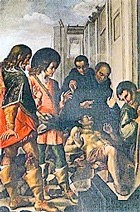

Cesare Sermei was born in Orvieto. His father, Ferdinando, was also a painter who undertook important commissions in Rome. He is documented in Rome in 1604 and seems to have trained there under Cesare Nebbia (who also came from Orvieto).
Cesare Sermei moved to Assisi in 16o8 and spent the last 60 years of his life here. He became a citizen in 1611 and Bishop Tegrimo Tegrimi created him a Cavaliere dell’ Ordine di Cristo in 1635. A number of works can be securely attributed to him on the basis of three volumes of autograph designs in the Biblioteca Comunale di Assisi.
Cesare Sermei executed frescoes (now lost) for the Chiesa del Nome di Gesù (also known as the Chiesa de' Matrigiani - see Walk III) with Vincenzo Giorgetti in 1631. He often worked with Vincenzo’s son, Giacomo Giorgetti and with Girolamo Martelli in the flood of “modernisation” that engulfed Assisi at that time.
Assisi
Martyrdom of St Catherine (1608)
This panel from Santa Caterina is the earliest known work that is signed by Cesare Sermei and dated. He described himself as “Urbevetani” (from Orvieto) because he painted the panel before he became a citizen of Assisi (in 1611). [Where is it now??]
Decoration of the Cappella di San Giovanni Battista (1608)
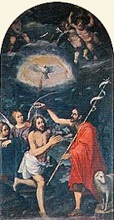
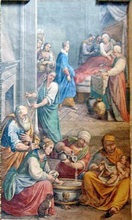
This chapel in Santa Maria degli Angeli belonged to the Locatelli family, who financed its decoration from the estate of Bernardino Locatelli (died 1602). Its decoration is attributed to Cesare Sermei and dated with reference to his other early works in Assisi. It comprises:
-
✴the altarpiece, which depicts the Baptism of Christ (illustrated above, to the left);
-
✴the panels on the walls, which depict scenes from the life of St John the Baptist, including the scene of his birth (on the left wall, illustrated above, to the right); and
-
✴the frescoes in the vaults, which also depict scenes from the life of St John the Baptist.
Scenes from the life of St Antony of Padua (1610)
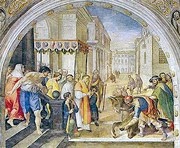
Fr Ignazio Vanzini commissioned these frescoes from Cesare Sermei, as part of the restoration of the Cappella di Sant’ Antonio da Padova in the Lower Church of San Francesco. The scenes depicting include this one on the right wall, in which a starving mule chooses to kneel before the Eucharist rather than to eat the food set out for him nearby. This miracle convinced the heretic who owned the mule to become an orthodox Catholic.
Last Judgement (1623)
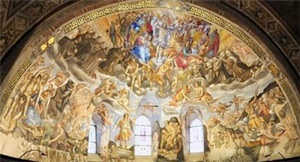
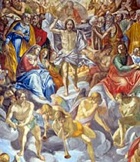
Work in Chiesa Nuova (ca. 1621)

-
✴the altarpiece on the high altar, which depicts a dream of the St Francis (illustrated here);
-
✴the frescoes in presbytery, which depict scenes of the martyrdom of (mainly) Franciscan saints;
-
✴monochrome frescoes os scenes from the life of St Clare in the Cappella di San Pietro d’ Alcantara; and
-
✴monochrome frescoes os scenes from the life of St Bernardino of Siena in the Cappella di San Bernardino da Siena.
St Francis blessing Assisi (1626)

A document of 1841 records that Cesare Sermei painted this panel and presented it to the Commune in gratitude for the award of citizenship of Assisi (an event that was wrongly dated as 1596 instead of 1611). The panel was also documented again in 1884, when it was in the Sala del Consiglio of the Palazzo dei Priori. It is now in the Pinacoteca Comunale.
In the panel, two friars support the stricken St Francis as he blesses the Assisi as he is being taken from Palazzo Vescovile to the Portiuncula, which was where he wanted to die. He is surrounded by the civic leaders of Assisi. The kneeling figure to the right holds an inscription that gives the date and the text of the blessing of St Francis from the “Liber de conformitate” (1399) of Bartholomew of Pisa. This figure is probably a self-portrait of Cesare Sermei, and the arms to his right are probably his own. The three women behind him probably represent Virtues.
Frescoes (1630-8)
The friars commissioned these frescoes from Cesare Sermei for the vaults of the sacristy of the Lower Church of San Francesco, which had been remodelled in 1626-8. They were destroyed in a fire in 1952.
Decoration of the Cappella delle Stimate (ca. 1631)
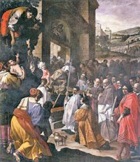
-
✴the panel of St Clare and her sisters grieving over the body of St Francis outside San Damiano (on the right wall, illustrated here);
-
✴the fresco of the Approval of the Franciscan Rule (in the vault); and
-
✴the fresco of St Francis welcomed in Heaven (also in the vault).
Panels from San Rufino
The Museo Diocesano contains four panels from San Rufino that are attributed to Cesare Sermei:
-
✴Three of them were removed in 1848 when their respective altars in the presbytery were demolished:
-
•Miracle of St Vitalis (ca. 1613)
-
The Confraternita di San Vitale commissioned this altarpiece for the Altare di San Vitale in the presbytery, where it was first documented in 1613. It depicts a miracle of St Vitalis, in which he restored the speech of a young man who was dumb. Successive bishops of Assisi objected to this subject (probably because there was no foundation for the miracle), but attempts to remove the altarpiece in 1632 and 1659 came to nothing.
-
•Madonna and Child with St Francis (ca. 1636)
-
Bishop Tegrimo Tegrimi built the Altare di San Francesco in the presbytery and subsequently commissioned this altarpiece for it from Cesare Sermei. It was removed in 1848 when this altar was demolished. It depicts St Francis receiving the baby Jesus from the lap of the Madonna.
-
•SS Jerome and Rufinus d' Arce (ca. 1637)
-
In 1637 ,Canon Girolamo Evangelisti rebuilt the Altare di San Rufinuccio in the presbytery and rededicated it to SS Rufinus d’ Arce and Jerome (his name saint). He also commissioned this altarpiece, which is attributed to Cesare Sermei. It was removed in 1848 when this altar was demolished. It depicts St Rufinus in front of the well into which he was thrown, holding a scroll inscribed with the word “veritas” (an allusion to the fact that the testimony that had provoked his martyrdom was actually true. The penitent St Jerome kneels on the rim of the well, with his lion below.
-
✴The fourth, which was first documented when it was restored in 1685, and was documented again in the sacristy of San Rufino in 1746, can be securely attributed to Cesare Sermei on the basis of a surviving design. It presumably came from San Rufino, although its original location there and the date of its execution are unknown. It depicts three saints:
-
•the standing St Rufinus with the mill stone to which he was tied during his martyrdom by drowning, with two flying angels holding crowns above his head;
-
•the standing St Cesidius, holding the palm of martyrdom; and
-
•the kneeling St Rufinus d’ Arce holding a scroll proclaiming the truth of the testimony that led to his martyrdom.
St Francis blessing Assisi (1640)
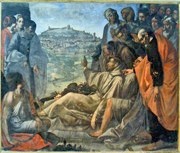
A document of 1806 records that Bishop Tegrimo Tegrimi (1630-41) commissioned Cesare Sermei to paint frescoes of scenes from the life of St Francis for the Sala Maggiore (main hall) of Palazzo Vescovile. Unfortunately, they were destroyed when the palace was restored after the earthquake of 1832. This panel, which was moved from Palazzo Vescovile to San Rufino in ca. 1685 presumably formed part of the same project: original designs for it by Cesare Sermei survive, and a lost inscription bore the date 1640.
The panel, which is now in the Museo Diocesano, depicts St Francis blessing Assisi as he is being taken from Palazzo Vescovile to the Portiuncula, which was where he wanted to die. The figure standing on the right is probably a portrait of Bishop Tegrimi.
Frescoes (1645-7)
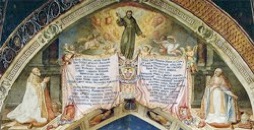
Frescoes attributed to Cesare Sermei in the narthex of the Lower Church of San Francesco include this depiction of St Francis in glory with Popes Sixtus V and Paul V, which is on the inner surface of the entrance arch. It was part of a programme of work that the friars commissioned from Cesare Sermei and Girolamo Martelli.
Scenes from Life at Rivotorto (1653)
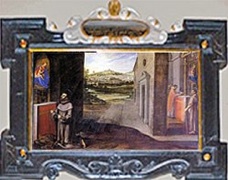
Fra. Michelangelo Catalano, the Minister General of the Conventual Franciscans, commissioned these twelve panels from Cesare Sermei for Santa Maria di Rivotorto. They depict scenes from the lives of St Francis and his companions at their original hermitage on this site. The panel illustrated above depicts St Francis praying at the Portiuncula: the church to the right is a representation of what was then the newly completed Santa Maria di Rivotorto.
St Nicholas of Bari (17th century)
This panel of the standing saint was documented in 1717 on the high altar of San Nicolò di Piazza, with an attribution to Cesare Sermei. The document also attributed five frescoes in the presbytery, which depicted SS John the Baptist, John the Evangelist and the Cardinal Virtues, to Cesare Sermei but these were destroyed in the earthquake of 1832. The panel survived and is now in the Museo Diocesano.
Bettona
Scenes from the life of St Crispoltus (1797)
These frescoes in the left transept of San Crispolto are copies of the original cycle (ca. 1615) of 36 scenes by Cesare Sermei. When it was decided that the originals should be destroyed during the restoration of the church in 1797, the friars commissioned these faithful copies from Stefano Notari. The original designs by Sermei survive in Assisi.
Foligno
Martyrdom of SS Crispin and Crispinian (ca. 1640)
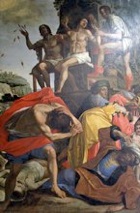
The altarpiece is attributed to Cesare Sermei: preparatory sketches, that are almost certainly his work survive in Assisi. The altarpiece was probably painted between 1635, the year in which the stucco decoration of the altar was executed, and 1642-4, when it was gilded. It is now in the Museo Diocesano.
Perugia
Frescoes (1620)
The frescoes in the vault of the nave of the ex-church of Santa Caterina Vecchia are dated by inscription. A second, now-illegible inscription recorded the name of the donor, Cristina degli Oddi. The frescoes depict:
-
✴six of the theological and cardinal virtues; and
-
✴three scenes from the life of St Catherine of Alexandria.
These frescoes can be securely attributed to Cesare Sermei on the basis of surviving preparatory sketches in Biblioteca Comunale, Assisi.
Frescoes (1630)
These frescoes by Cesare Sermei in the ex-church of Santa Maria Maddalena delle Repentute [can be seen through the window in the cloister ?]. The scenes include:
-
✴the Assumption of the Virgin;
-
✴St Mary Magdalen in glory;
-
✴St Mary Magdalen contemplating a crucifix; and
-
✴St Maximian administering the sacrament to St Mary Magdalen.
St. Maurus raising a man from the dead (1648)
Frescoes (17th century)
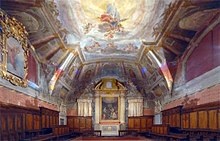
These frescoes in the vaults of the Oratorio dei Nobili of the Chiesa del Gesù are by Cesare Sermei and Girolamo Martelli.
Coronation of the Virgin (17th century)
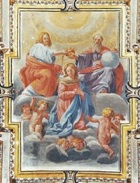
Spello
Miracle of the Blessed Andrea Caccioli (ca. 1610)
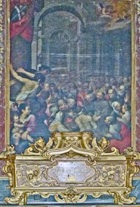
Panels (17th century)
The following panels in Santa Maria di Vallegloria are attributed to Cesare Sermei:
-
✴the stigmatisation of St Francis (1627), on the left wall;
-
✴the triumph of Christian mortification, also on the left wall; and
-
✴a miracle of the Blessed Pacifica (one of the first nuns at Vallegloria) in the garden of the nunnery, on the right wall.
Frescoes (ca. 1625)
Two frescoes in the church of San Ventura are attributed to Cesare Sermei:
-
✴St Felician preaching at Spello, on the right wall; and
-
✴a miracle of the Blessed Andrew Caccioli, opposite, in which he brings to life a dead man outside the church of Sant’ Andrea..
The choice of these subjects was probably intended to boost the claim for the Blessed Andrea to be declared the sole patron saint of Spello by suggesting that St Felician (the patron saint of Foligno) rather than St Felix had been the true evangelist to the town. However, it was, in fact, St Felix who was appointed as the sole patron saint of Spello in 1629.
Todi
Scenes from the Passion of Christ (1612)
This fresco cycle on the walls and ceiling of the Cappella della Crocifissione of Santa Maria di Montesanto is signed by Cesare Sermei. He described himself as “Assisas” (from Assisi): this is, in fact his earliest known altarpiece from the period after 1611, when he became a citizen of Assisi.







